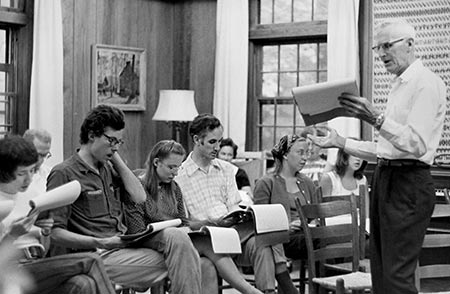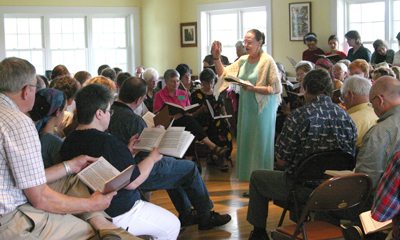02 Jul 10 Reasons to Try Shape Note Singing
For anyone who loves to belt it out in the shower, was moved by the church scene in Cold Mountain with everyone belting it out together, or is simply a fan of “belting it out” in life, Shape Note singing is for you!
Every time I have participated in a sing, I have been overcome with the sort of pure emotion that stems from being truly “in the moment” without even realizing it. It is incredibly refreshing and I whole-heartedly recommend it as a great way to spend a summer-time Saturday.
My top 10 favorite things about Shape Note singing (in no particular order):
#1. You don’t have to know how to read music or find harmonies. You can just relax and follow the singing leaders and shapes that resemble each note on the page.
#2. Sitting next to a seasoned singer helps you sound like a seasoned singer (It’s the same theory as a lead biker “breaking the wind” for the riders behind them).
#3. The more raw, gutsy and untrained your way of singing, the better it sounds.
#4. You are not alone! This is true togetherness through song. It is basically a room full of 4 part harmonies happening simultaneously. A perfect opportunity to melt into the crowd.
#5. The harmonies are so different from what you typically hear. They sound so old and heart wrenching… SO beautiful.
#6. Singing increases oxygen to the brain, releases endorphins and reduces stress. All good things, right?
#7. It is a different way to meet folks from our region. At the Folk School sing North Carolina, South Carolina, Georgia, Tennessee and even Alabama are often represented.
#8. It is a safe space for people of all different beliefs and is simply intended as a mode to celebrate joyful living.
#9. The Saturday sing doesn’t drain your go-out-and-have-fun budget. It’s free!
…and last, but not least
#10. There is a “potluck on the grounds” which is code word for “the best southern comfort food in town.” Mmmm….
Join us this year:
28TH ANNUAL FOLK SCHOOL SHAPE NOTE SING SING
Saturday, July 8, 2023, 9:00 a.m. – 3:00 p.m.
Location: The Open House (open air pavilion by the Folk School Gardens)
Beginning at 9:00 a.m., there will be an introduction to singing Sacred Harp and Christian Harmony music for beginners. Some loaner books are available.
Singing: 10:00 a.m. – 3:00 p.m.
Dinner on the grounds at Noon
After party: 7:00 p.m. Contra & Cajun Dance
Come sing, learn the shapes, contemplate the poetry, and relish the power of voices raised together in song. These events welcome first-timer and experienced shape note singers to sing from the tune books Christian Harmony and The Sacred Harp. Experience the beauty of singing 4 parts unaccompanied. All shape note singings are free and open to the public.
Admission to the singing is free.
Donations are welcome.
There will be copies of the Christian Harmony book available for sale at the singing for $25 each and a few available to borrow or you can order
them at Christian Harmony.
Hear a sample of Shape Note Singing by Alabama Sacred Harp Singers – “Present Joys” recorded in 1942 by Alan Lomax for the Library of Congress:





Jane Spencer
Posted at 13:12h, 03 JulyShape notes are musical notes and were invented to facilitate the reading of music. So, #1 would be basically wrong. The author then soon contradicted herself about harmonies mentioned in #1 in #4.
Cory Marie Podielski
Posted at 15:17h, 04 JulyResponse from the author:
Hello Jane,
I very much do understand that “shape notes are musical notes invented to facilitate the reading of music” which is explained in the lower portion of the blog. Maybe I didn’t make it clear enough. My intention was to write in a way that was friendly and inclusive as well as not too technical in order to encourage anyone who has heard of shape note singing and might be shy to give it a try. I was trying to imagine/remember the process a beginner goes through in using the shapes to learn to read music. When I was young and learning the shapes, I simply followed someone singing “my part” and used relative sight reading from that point, I wasn’t actually reading music. Over time I was able to more confidently associate each shape with the correct note, rather than just the relative sight reading. And the beauty of it is that wonderful harmonies grow out of it, even if we are still trying to learn the shapes/notes simply because of singing in a group. This is all I meant by #1 and #4 on the list.
Happy Singing,
Annie Fain
Stephen Shearon
Posted at 13:56h, 03 JulyConcerning your statement, “William Walker’s Christian Harmony is the oldest seven shape collection to have remained in continuous use,” take a look at Joseph Funk’s Harmonia Sacra. In the fifth edition of Funk’s collection, dated 1851, he used seven-shape notation (his own system), and it has been used in that publication ever since (although after 1876 his descendants switched to Aikin’s system). To the best of my knowledge, the oldest seven-shape publication is Jesse B. Aikin’s The Christian Minstrel (1846), but I’m not aware that it remained in continuous use anywhere.
Cory Marie Podielski
Posted at 16:35h, 03 JulyThanks Stephen for the comment and the historical perspective. I revised the blog to be more accurate.
Amy Buckingham
Posted at 08:58h, 12 AugustThanks for the sound byte, Annie Fain! And thank you for the encouraging words that everyone can do this. It is enjoyable at the least, sometimes even euphoric to sing with a Shape Note group. Sorry I couldn’t make it this year.